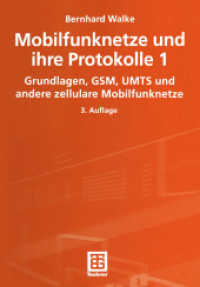Full Description
The concept of a public sphere has traditionally been associated with urban spaces. Public Spheres After Socialism contests this in light of shifts of perspective in the East and West after the end of the Cold War and the disintegration of the Soviet Union.Public Spheres After Socialism draws together contemporary experiences from Armenia - an interesting site of cultural and political cross-currents - Germany, Austria, France and the United Kingdom. It reconsiders the concept of a public sphere as a figurative, or mythical, location in which the members of a society shape and determine its values and ask to what extent this public sphere exists or is viable today. Among the ideas presented in this groundbreaking volume are the cultures of public time, everyday memorials, urban reconstruction, film as a dialogic site, and the mapping of a post-socialist city in youth culture.Esteemed academics cover a wide range of issues, including public spaces and monuments, urban reconstruction, film, new media and communication. They explore the major shifts in theory and consider how the dualism of the Cold War has been replaced by the single ideological position of globalized consumerism.
Contents
Preface - Page 7 - Angela Harutyunyan Chapter 1: 'Peace in Ruins: The Value of Mementoes, Temporary Shrines and Floral Tributes as Markers of the Public Sphere' - Page 11 - Paul Gough Chapter 2: 'State Icons and Narratives in the Symbolic Cityscape of Yerevan' - Page 19 - Angela Harutyunyan Chapter 3: 'Public Sphere as a Place for Gifts: Social-symbolic Characteristics of the City-building of Post-Soviet Yerevan' - Page 29 - Nazareth Karoyan (trans. A. Harutyunyan) Chapter 4: 'Cinema as Political Movement in Democratic and Totalitarian Societies since the 1960s' - Page 39 - Anna Schober Chapter 5: 'Public Space: The City in Armenian Literature' - Page 63 - Vardan Jaloyan (trans. A. Harutyunyan) Chapter 6: 'You Tell Me: A Topography' - Page 71 - Jane Rendell Chapter 7: 'Routes through the City: Youth Identities and Spatial Practices in Leipzig' - Page 91 - Kathrin Horschelmann Chapter 8: 'New Social Order and Change in Media Landscape' - Page 111 - Hrach Bayadyan (trans. A. Harutyunyan) Chapter 9: 'Remote Control: Dangers and Delights of Armenian TV Surfing' - Page 119 - Vahram Martirosyan (trans. A. Harutyunyan) Chapter 10: 'Time without Qualities: Cracking the Regime of Urgency ' - Page 129 - Stephen Wright Chapter 11: 'Public Spheres' - Page 133 - Malcom Miles








